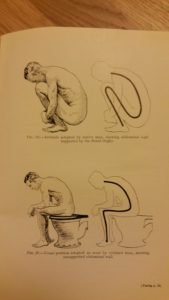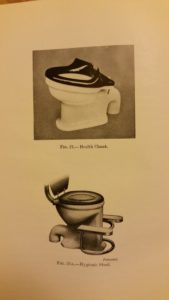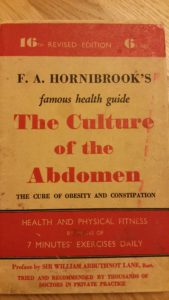By Lisa Smith (Regular Contributor)
My grandfather, Elmer Smith, died in 1948. One of his personal effects recently found its way onto my dad’s bookshelf—it being an old book that no-one had much use for: F.A. Hornibrook’s The Culture of the Abdomen. We’re not even 100% sure that the book did belong to Elmer. There are no personal marks, just a feeling, or distant memory, on the part of my aunt (who had found it while doing a clear-out) that the book was probably her father’s.
I’m inclined to agree.
The first edition of Hornibrook’s popular health guide appeared in 1924, but this was the sixteenth edition, published in 1946. And that, I think, is the clue. Elmer, you see, died of bowel cancer.
Hornibrook’s book was subtitled ‘the cure of obesity and constipation’ and focused on fixing the middle-aged spread in men. It’s great fun to read, with gems such as this:
His digestion is a mockery, gurgling and groaning in hopeless disability, his breath reminiscent of a Limburger cheese, and his general outlook upon life a pessimistic wail (7).
The exercises have much to offer the modern reader, as they are essentially about building core strength, including such staples as cat-arches, pelvis tilts, and belly dancing. Yes, you read that correctly, or, as Hornibrook put it: ‘abdominal muscle training, based upon the body-dance exercises of native races’ (19).
And the creator of the modern Squatty Potty was clearly influenced by Horniman’s advice on using a hygienic stool when at toilet. Throughout the book, Hornibrook compares unfavourably the bodily knowledge and practices of the West with ‘native’ cultures from around the world.

 The Culture of the Abdomen is not about cancer, but the possibility of cancer runs as a dark theme through the book: the constipation that comes with civilisation and its bad habits was to blame for cancer. In the modern world, Hornibrook complained, people ate too often and excessively, and relied too much on purgatives, which ruined the bowels. Worst of all, emptying bowels was ‘a matter of shame, to be performed in secret, and at as long intervals as mechanical requirements permit’ (6).
The Culture of the Abdomen is not about cancer, but the possibility of cancer runs as a dark theme through the book: the constipation that comes with civilisation and its bad habits was to blame for cancer. In the modern world, Hornibrook complained, people ate too often and excessively, and relied too much on purgatives, which ruined the bowels. Worst of all, emptying bowels was ‘a matter of shame, to be performed in secret, and at as long intervals as mechanical requirements permit’ (6).
Problems started in infancy, with babies being ‘held out’ (elimination toilet-training) at their carers’ convenience rather than when the child felt the urge. This carried through into youth, where school-masters ‘deemed [time] wasted when spent at stool’ (9). But the body, Hornibrook believed, could be retrained through exercises, posture and habits.
Elmer likely special-ordered the book, which came all the way from Toronto, Canada to small-town Alberta, as suggested by a tag on the inner-leaf for ‘Health Books Supply Co.’ It is not hard to imagine that Elmer was already suffering from early symptoms of cancer—constipation or looseness, or even rectal bleeding and stomach aches—when he bought the book. Perhaps he, like Hornibrook, put symptoms like constipation down to middle-age and diet. Perhaps he hoped that ‘for a small expenditure of time and trouble we gain efficiency of body, alertness of mind, and a general feeling of well-being’ (54).
I can only hope that when his disease became clear, Elmer didn’t follow Hornibrook too closely in blaming himself:
For the neglect of our bodies, for over-indulgence, for laziness, we have all to pay the price one way or another, and that price is usually a heavy one. (54)
 Elmer died young, only in his 30s, and left behind him five children–three of whom were seven or under. His widow, my grandmother, never remarried; she died only a few years later, when her heart gave out… was it the strain of caring for several children on her own? But there is no one left who would have been old enough at the time who could answer these questions, as the two eldest sons in the family also died in their 30s from bowel cancer. Elmer’s death has cast a long shadow on the family, more for the heredity of the disease—for which family members are still regularly tested—than for any memories of the father, whose children were too young to really know him when he died.
Elmer died young, only in his 30s, and left behind him five children–three of whom were seven or under. His widow, my grandmother, never remarried; she died only a few years later, when her heart gave out… was it the strain of caring for several children on her own? But there is no one left who would have been old enough at the time who could answer these questions, as the two eldest sons in the family also died in their 30s from bowel cancer. Elmer’s death has cast a long shadow on the family, more for the heredity of the disease—for which family members are still regularly tested—than for any memories of the father, whose children were too young to really know him when he died.
The book may not have any markings to indicate Elmer’s usage of it, but it nonetheless represents our legacy: a culture of the abdomen that still shapes the family today.

